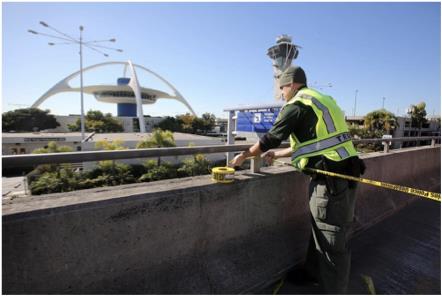Emergency Management Division.
Los Angeles World Airports is required to comply with the mayor’s emergency
preparedness Directives #15, #17, #18, and #19 as amended. In addition, LAWA must adhere to the
requirements of Title 14 Code of Federal Regulations (CFR) Part 139.325 Airport Certification
Requirements for Emergency Incidents.
To carry out these responsibilities, Emergency Management plays an integral role in helping our airports
prepare for emergencies so they can continue to meet the global demand for passenger, cargo, and general
aviation services. Our efforts have directly impacted the resilience our transportation system making it
a safe place for its customers and the residents of the City of Los Angeles.
Our Partners
In order to achieve this goal, Emergency Management works with multiple partners who have jurisdictional authority to respond to incidents at our airports.
- LAWA Employees
- Commercial, Private, and Cargo Air Carriers
- Service Providers
- Concessionaires
- Federal, State, County, Local Government Agencies, and NGOs

Program Areas
Working Groups and Committees
To promote information sharing and collaboration, Emergency Management facilitates regular working groups and committees to build and strengthen our airport’s capabilities. Meetings are not open to the public. If you are badge holder or airport partner and would like to participant, please contact the Emergency Management Division.
Airport Response Coordination Center (ARCC)
The ARCC serves as LAWA’s interdivisional operational communication and coordination hub as well as our Department Operations Center (DOC), in accordance with the City of Los Angeles policies. It is a centralized information facility, comprised of multiple organizations with their own unique chains of command and authorities. Emergency Management is charged with synchronizing all aspects of the ARCC’s business operations including planning, organization, equipment, training, exercises, and continuous improvement.
Alert and Warning
Emergency Management maintains a mass communication system called LAWA Alerts. It is used to send information during emergencies, operational disruptions, and planned events impacting LAX and VNY airports directly from our Airport Response Coordination Center. LAWA has also been approved by the Federal Emergency Management Agency (FEMA) to send Wireless Emergency Alert (WEA) messages during an airport emergency which causes a threat to life, property, or the environment. For more information about LAWA Alerts and our WEA capabilities, follow this link.
Operational Coordination
EMD establishes a unified and coordinated operational structure and processes to integrate all airport response partners to deliver critical services during emergencies.
Planning, Training, and Exercises
Emergency Management maintains our response and continuity of operations (COOP) plans, such as the Airport Emergency Plan and Emergency Operations Plan for the airports in accordance with applicable federal and city policies.
To request a copy of our emergency plans, airport partners can contact the Emergency Management Division.
Emergency Management supports the LAWA Emergency Management Training Course for airport tenants. Formerly known as the Tenant Suite, more information about this program can be found by following this link.
On a triannual basis, Emergency management coordinates the conduct of the FAA required Air Exercise at LAX, to evaluate LAWA’s emergency preparedness and to propose solutions to correct areas for improvement. Emergency Management conducts and participants in other exercises throughout the year to increase our preparedness posture.
Interoperable Communications
Emergency Management supports the development of strategies and tactics for emergency response partners to communicate among divisions and organizations at all levels of government operating at our airports.
Threat and Hazard Identification
Emergency Management works with our Public Safety Group to identify and assess threats and hazards that occur in our airport’s geographic areas, including their frequency and magnitude.
